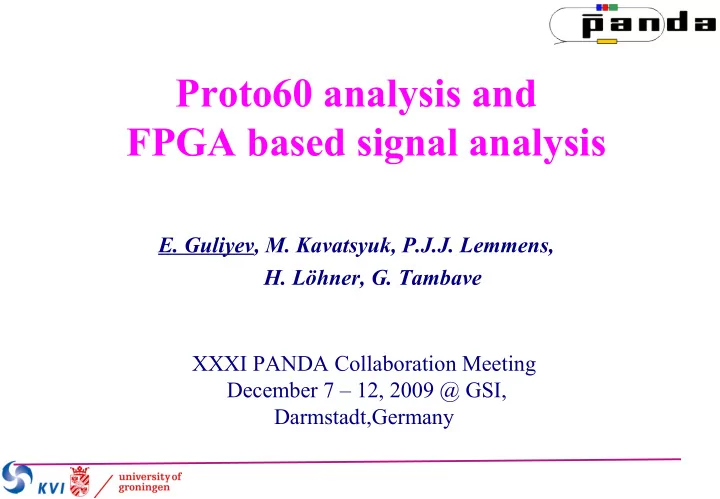

Proto60 analysis and FPGA based signal analysis E. Guliyev, M. Kavatsyuk, P.J.J. Lemmens, H. Löhner, G. Tambave XXXI PANDA Collaboration Meeting December 7 – 12, 2009 @ GSI, Darmstadt,Germany
Outline: 1. Status of fitting of energy response 2. Status of FPGA board 2
Calibration Cosmic muon energy deposition in PWO crystals Poor Calibration spectrum Good Calibration spectrum Cluster-energy resolution is limited by the precision of the calibration There is not enough statistics! The new measurement is required! 3
Energy resolution for Proto60 Previous result Recent result σ/Ε = 1.72 %/ sqrt(E) + 0.94 % σ Gauss /Ε ∗100 % Energy, GeV FWHM /2.35/Ε = 5.4 % @ 0.12 GeV FWHM Gauss /2.35Ε = 4.9 % @ 0.12GeV FWHM /2.35/Ε = 2.6 % @ 1 GeV FWHM Gauss /2.35/Ε = 2.2 % @ 1 GeV 100 MHz 16 SADC was used 4
2 different fit functions Energy response @ 1 GeV Fitted: 1. Non-symmetric Gaussian function 2. Novosibirsk function FWHM N sym G = 1.6e-01 a.u. FWHM Novosibirsk = 1.3e-01 a.u. 5
2 different fit functions Fit Parameters, Fit Functions a.u. Non-Sym Gauss Novosibirsk Amplitude 2.6e+02 2.8e+02 Sigma Gauss 6.6e-02 5.4e-02 Sigma Tail 8.5e-02 4.9e-01 Mean 7.4e-01 7.4e-01 The Novosibirsk function fit "reports" better resolution! 6
FPGA -Field Programmable Gate Array Feature-extraction algorithm for the LNP preamplifier recently developed @ KVI by P. Lemmens XILINX Spartan development board The board ready for testing RS – 232 Serial port Connection Analyze off-line Proto60 data in FPGA ! 7
Input: DATA Output Single Trace MWD Triangular shape The processed pulses are coming out of the board only in the debugging mode During the analysis one gets only energy and time for the detected pulses 8
Summary: 1.Within collaboration we should agree which fitting function to use for the determination of the energy resolution. 2. FWHM for Gauss determined from Novosibirsk (0.13) Fit function is less than Non-Symmetric Gauss (0.16) fit function. 3. FPGA board programmed and ready for testing! Next Steps! Validation of the feature extraction algorithm implementation Direct event-by event comparison with the off-line analysis Porting VHDL code to the Febex16 board 9
BackUp Slide 0. Copy of input-data stream 1. Short pulse (MWD) 2. Triangle pulse (MWD+MA) 3. Sawtooth pulse 4. Smoothed pulse 5. Noise 6. MWD baseline 7. Zero-crossing 8. Gating signal 9. Event energy measurement 10. – 15: Event data 10
Recommend
More recommend